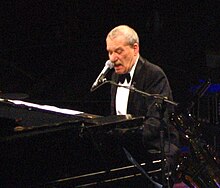music.wikisort.org - Poet
Paolo Conte (Italian pronunciation: [ˈpaːolo ˈkonte]; born 6 January 1937) is an Italian singer, pianist, songwriter and lawyer known for his distinctly grainy, resonant voice. His compositions fuse Italian and Mediterranean sounds with jazz, boogie and elements of the French chanson and Latin-American rhythms.
This article may be expanded with text translated from the corresponding articles in Italian and German. (January 2022) Click [show] for important translation instructions.
|
Paolo Conte | |
|---|---|
 Paolo Conte in Berlin | |
| Background information | |
| Born | 6 January 1937 Asti, Piedmont, Italy |
| Genres | Jazz, Chanson |
| Instrument(s) | Vocals, piano, kazoo |
Career
Conte was born in Asti, Piedmont. His parents were avid jazz fans and Conte and his younger brother Giorgio spent their formative years listening to a lot of early jazz and blues recordings. After obtaining a law degree at the University of Parma, Conte started working as an assistant solicitor with his father, simultaneously pursuing his musical studies. He learned to play the trombone, the vibraphone and the piano,[1] and formed a jazz band with his brother on guitar. Conte's skill for composing music and original arrangements was noted by music producer Lilli Greco, who paired Conte with lyricist Vito Pallavicini. They wrote songs for Adriano Celentano ("Azzurro", 1968), Caterina Caselli ("Insieme a te non ci sto più", 1968), Fausto Leali ("Deborah", 1968) and Enzo Jannacci ("Messico e nuvole", 1970). In 1974 Conte recorded his first album, Paolo Conte. The following year, he released another eponymous album. Following a series of well-received shows at Club Tenco in Sanremo in 1976 and the commercial success of his third album, 'Un gelato al limon', Conte concentrated almost exclusively on his solo career.
Some of Conte's most popular songs have been used as film soundtracks, including "Come Di" in I Am David (2003) and Mickey Blue Eyes (1999), "Via con me" in French Kiss (1995), Mostly Martha (2001) and Welcome to Collinwood (2002). In addition, Conte's song "L’orchestrina" is featured during the end credits for episodes 3 and 4 of the television series The New Pope (2020). In 1997 Conte won the Nastro d'Argento for Best Score for the film La freccia azzurra.
Awards
On 24 March 1999, Conte was awarded the Knight Grand Cross of the Order of Merit of the Italian Republic,[2] by President Giorgio Napolitano for his "outstanding cultural achievements". On 15 May 2001, France ordered Paolo Conte Chevalier dans l'Ordre des Arts et des Lettres. In 2015, Conte was awarded the Premio Galileo for contemporary music in Padua.[3]
Conte has also received several honorary doctorates, including one from the University of Macerata (1990).[4]
Discography

Studio albums
- Paolo Conte (1974)
- Paolo Conte (1975)
- Un gelato al limon (1979)
- Paris milonga (1981)
- Appunti di viaggio (1982)
- Paolo Conte (1984)
- Aguaplano (1987, double album - the Japanese and German releases were issued as two separate albums, the second titled Jimmy Ballando in 1989)
- Parole d'amore scritte a macchina (1990)
- 900 (1992)
- Una faccia in prestito (1995)
- Razmataz (2000)
- Elegia (2004)
- Psiche (2008)
- Nelson (2010)
- Snob (2014)
- Amazing Game (2016)
Live albums
- Concerti (1985)
- Paolo Conte Live (1988)
- Paolo Conte - Haris Alexiou (1990)
- Tournée (1993)
- Tournée 2 (1998)
- Paolo Conte Live Arena di Verona (2005)
- Live in Caracalla – 50 Years of Azzurro (2018)
Greatest Hits albums
- Come Di (1986, French release)
- Collezione (1988)[5]
- Boogie (1990)
- Wanda, stai seria con la faccia ma però (1992)
- The Best of Paolo Conte (1996)
- Reveries (2003)
- Wonderful (2006)
- Gong-oh (2011)
- The Platinum Collection (2014)
See also
- 2008: Ohrožený druh (featuring ""Jak se ten chlap na mě dívá" by Conte)
References
- "Paolo Conte, gli 80 anni dell'avvocato pianista che sullo spartito mette i sogni - la Repubblica". 5 January 2017.
- Grand Cross of the Order of Merit of the Italian Republic
- "Premio Galileo 2000: Edizione 2015".
- Carlo Moretti, "Il Cantautore in cattedra professore di leggerezza", la Repubblica, 10 April 2003, p. 48.
- Musicmeter
External links
На других языках
[de] Paolo Conte
Paolo Conte (* 6. Januar 1937 in Asti, Piemont) ist ein italienischer Cantautore (Liederdichter), Komponist, Multiinstrumentalist und Maler. Der jazzgeprägte Musiker gilt als einer der wichtigsten und innovativsten Cantautori Italiens.- [en] Paolo Conte
[es] Paolo Conte
Paolo Conte (Asti, 6 de enero de 1937) es un músico y compositor italiano, reconocido cantautor de música de variedades y cuya obra está influenciada por la música jazz y blues.[it] Paolo Conte
Paolo Conte (Asti, 6 gennaio 1937[2]) è un cantautore, compositore, polistrumentista e pittore italiano. Pianista di formazione jazz, è considerato uno dei più innovativi cantautori italiani[3]. Nella sua sessantennale carriera è stato autore di musiche per altri artisti, spesso collaborando con parolieri come Vito Pallavicini[4], per poi decidere, nel 1974, di abbandonare la carriera forense fino ad allora esercitata, per dedicarsi esclusivamente a quella artistica. Stimato e apprezzato dal pubblico francese e da varie platee internazionali, si è cimentato in altri campi espressivi, ricevendo nel 2007 una laurea honoris causa in pittura, conferitagli dall'Accademia di belle arti di Catanzaro[5]. Insieme a Fabrizio De André è l'artista con il maggior numero di riconoscimenti da parte del Club Tenco, con sei Targhe e un Premio Tenco. Ha inoltre ricevuto un Premio Chiara nell'apposita sezione Le parole della musica.[ru] Конте, Паоло
Па́оло Ко́нте (итал. Paolo Conte, 6 января 1937, Асти) — итальянский певец, пианист и композитор, известный благодаря своему необычному голосу, красочным и романтичным композициям (вызывающим ассоциации как с итальянской и средиземноморской музыкой, так и с южноамериканскими ритмами и франкоязычными исполнителями, такими как Жак Брель и Жорж Брассенс) и его задумчивой, иногда меланхоличной, лирике.Другой контент может иметь иную лицензию. Перед использованием материалов сайта WikiSort.org внимательно изучите правила лицензирования конкретных элементов наполнения сайта.
WikiSort.org - проект по пересортировке и дополнению контента Википедии